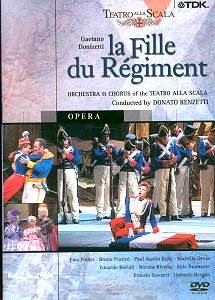La Fille du Regiment is set in the Tyrol
in the Napoleonic era and tells the story of Marie, the pretty
vivandiere of the 21st Regiment of the Grenadiers.
She had been found on the battlefield when she was a young child
and adopted and brought up by the soldiers as "the daughter
of the regiment". When Tonio, a young mountain lad, is caught
lurking around the camp, the Grenadiers seize him as a spy. Marie
however declares she loves him and explains that he had saved
her from falling off a precipice. But the soldiers have vowed
that Marie can only marry a member of the regiment. Tonio enlists
in the Regiment only to find that the Marquise de Berckenfield
claims Marie as her long lost niece and carries her off to groom
her for a glittering marriage into the aristocracy. In the castle
of the Marquise Marie rebels against being made a lady and the
regiment, with Tonio, now promoted to Captain, come to claim and
rescue her from an unwanted wedding.
The design of this La Scala production is by
film and opera director Franco Zeffirelli. The costumes and sets
are colourful and, mercifully, traditional. The soldiers’ uniforms
are authentic-looking and the gowns worn by Marie, the Marquise
and her aristocrat friends in Act II are sumptuous. Act I scenery
follows the contemporary cartoon style of Napoloeon’s middle-European
campaigns, while the Marquise’s brightly-lit palace music room
is elegant and spacious with huge picture windows looking out
onto an ornamental garden.
The Italian soprano, Mariella Devia might appear,
under close TV camera scrutiny, to be rather mature for the role
of Marie … but then so did Joan Sutherland in the 1960s in the
role. However she more than makes up for it in her delicious tomboy
sense of comedy and in managing Donizetti’s spectacular coloratura
passages with aplomb. Paul Austin Kelly matches her in a comic
performance in the role of Tonio, nicely treading the line between
the heroic and the absurd. He brilliantly masters the notorious
eight high Cs of his cavatina, ‘Pour son amen’. Bruno Praticő
is an engaging, swaggering Sergeant Sulpice. Ewa Podles is gravely
haughty in her Act I aria when, jealous of her honour, she rues
the advance of Napoleon’s troops. The tuneful soldiers’ choruses
are suitably stirring.
Of course one of the delights and highlights
of this opera is the hilarious Act II Music Lesson. The Trio of
Marie, Marquise and Sulpice are comical enough but they cannot
dispel for me, memories of the funnier, far sharper performance
of this scene with Joan Sutherland as Marie, Monica Sinclair as
the Marquise de Berckenfield and Spiro Malas as Sulpice in the
celebrated 1968 Richard Bonynge Decca recording.
This is a bright and breezy production of Donizetti’s
comic opera that will surely delight fans of bel canto.
Ian Lace
